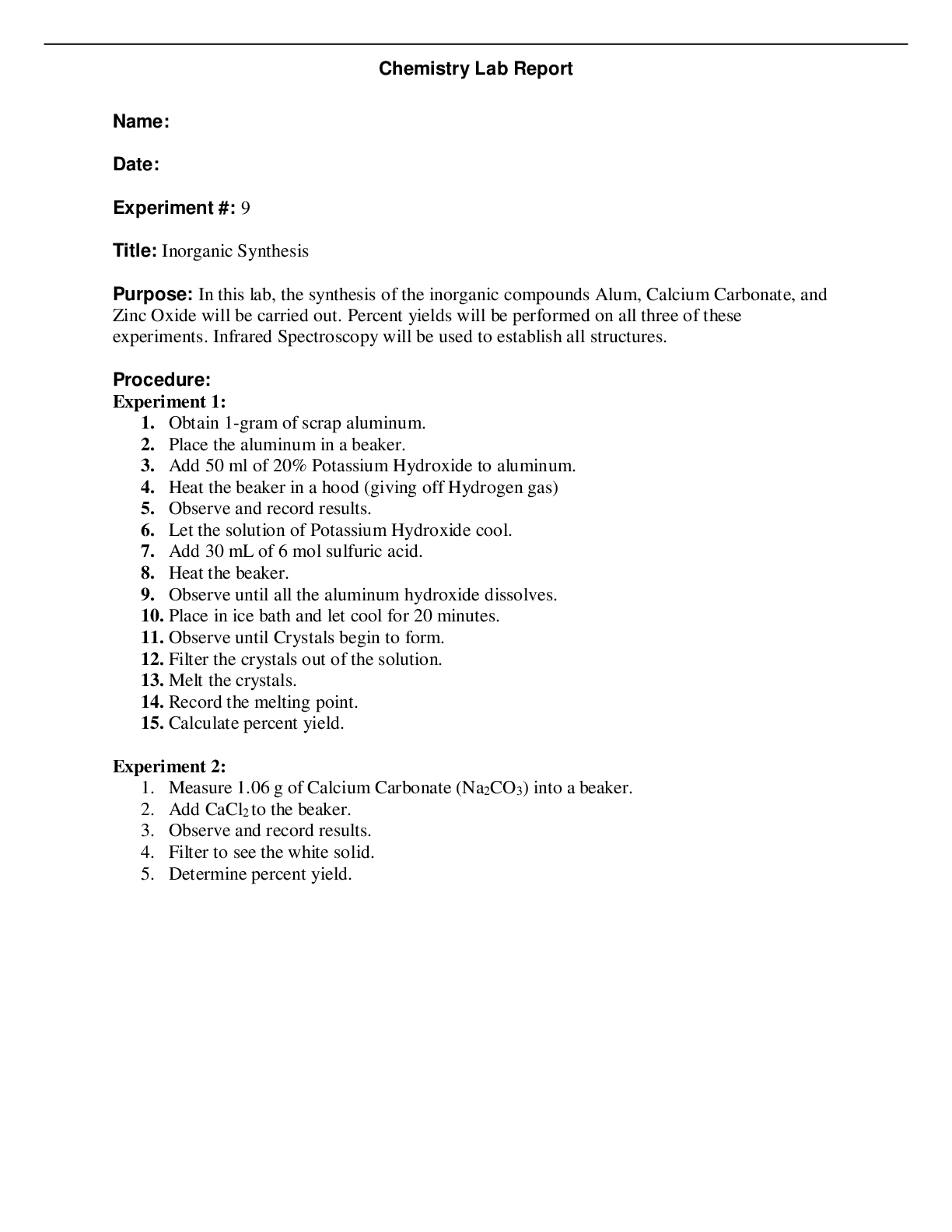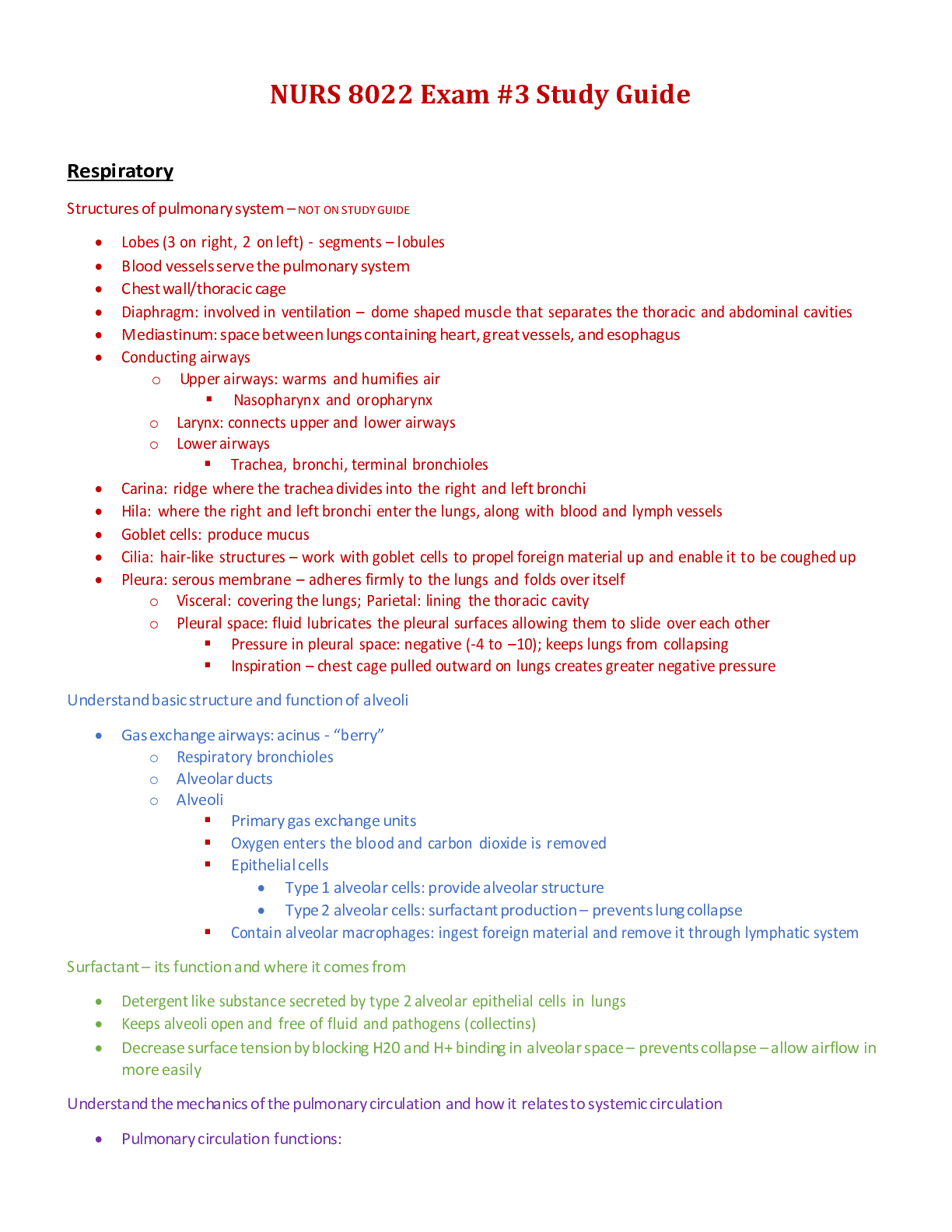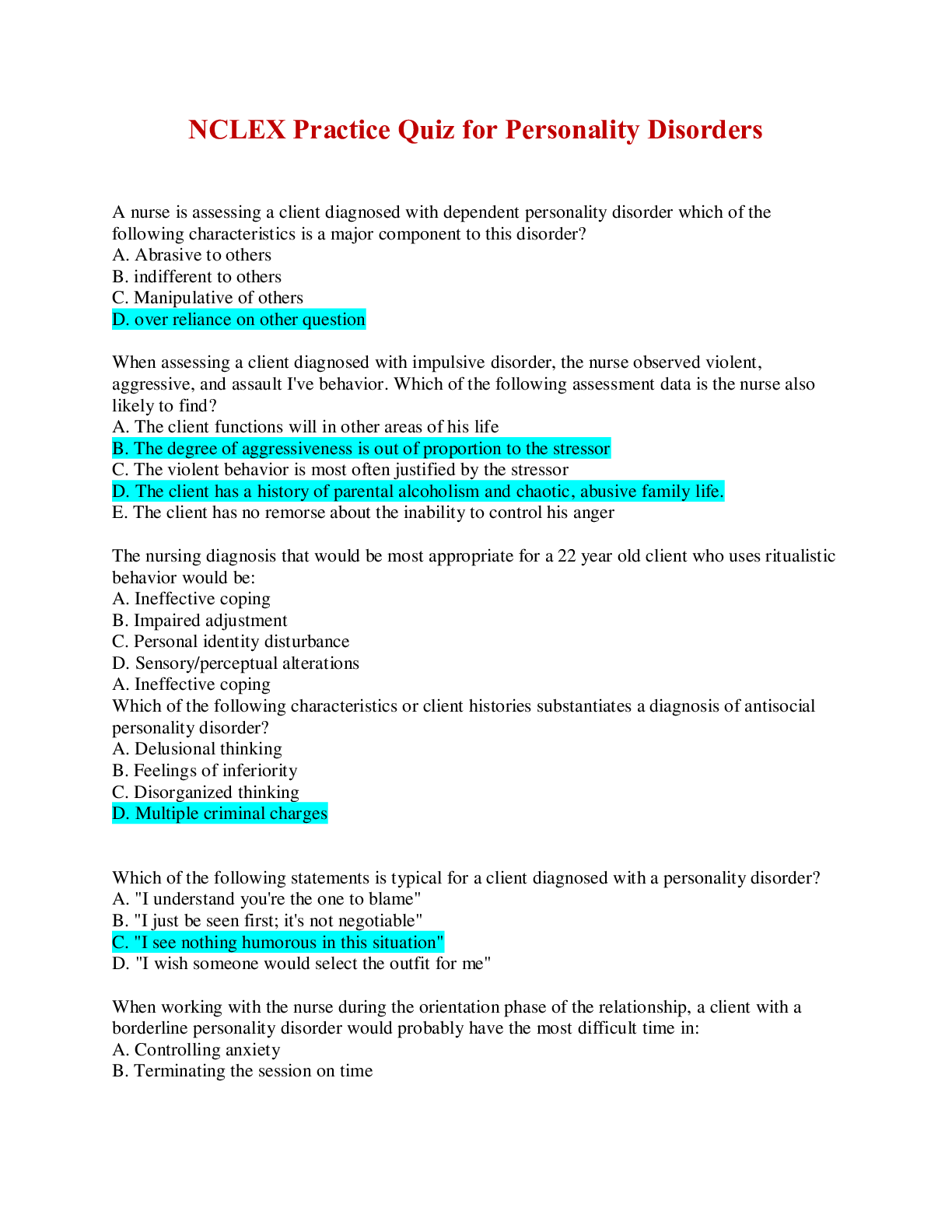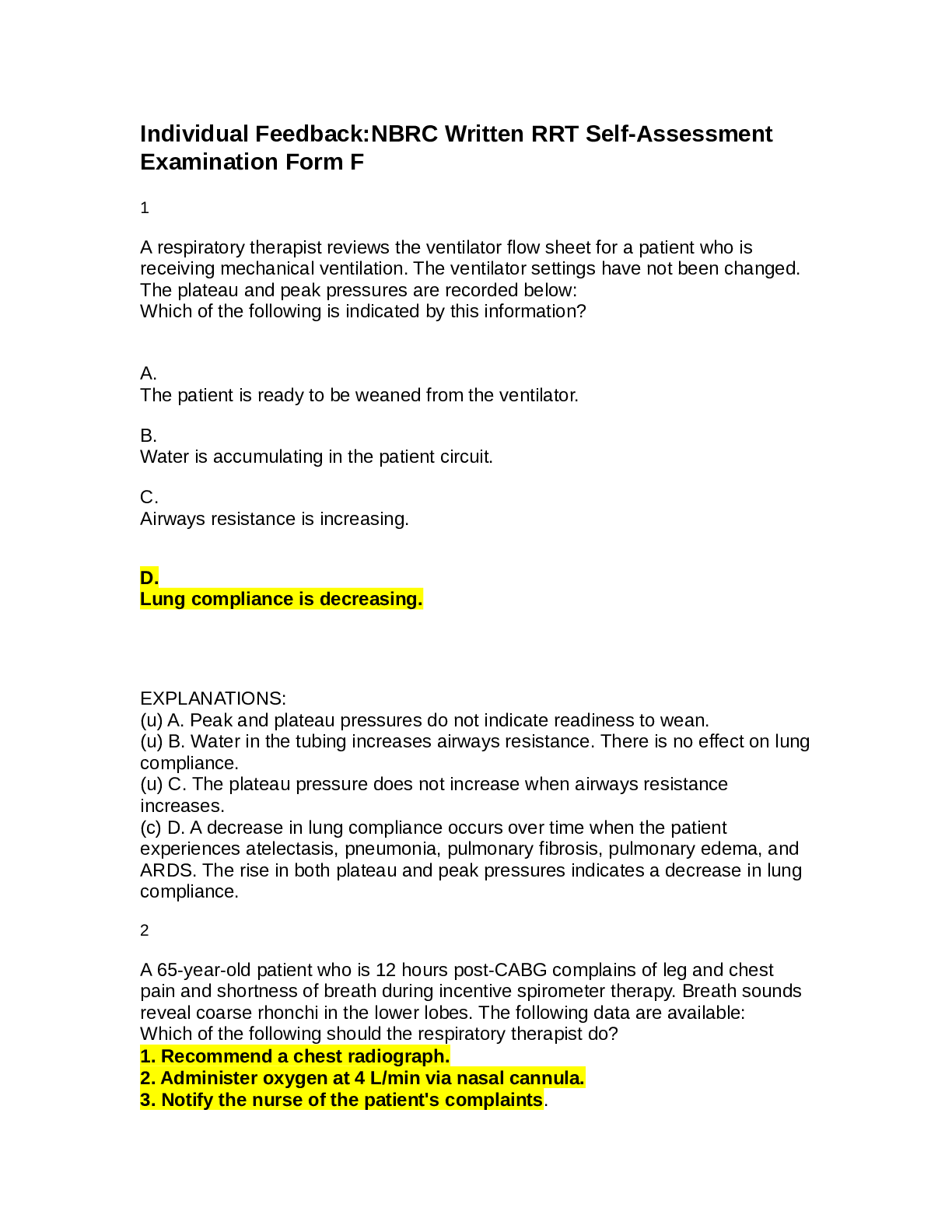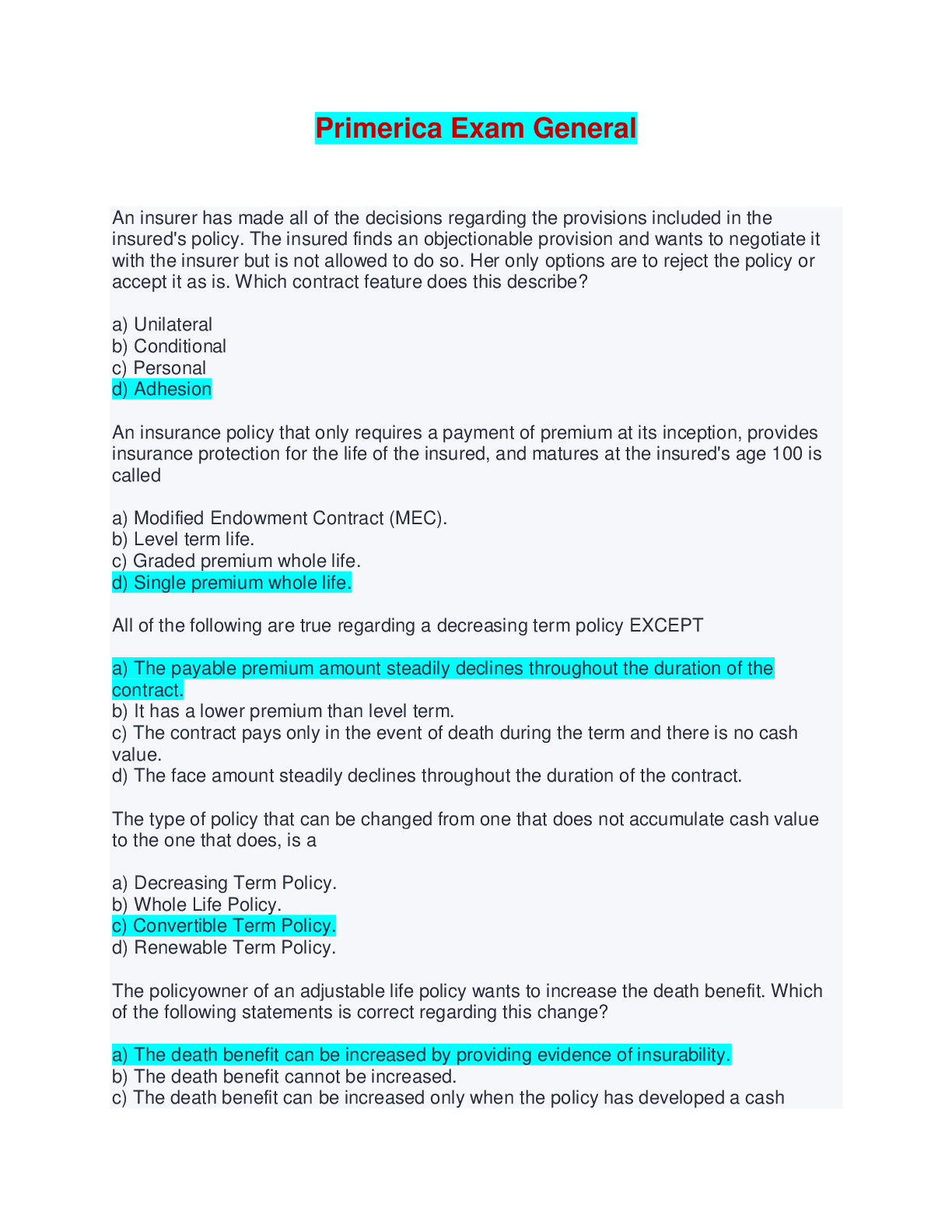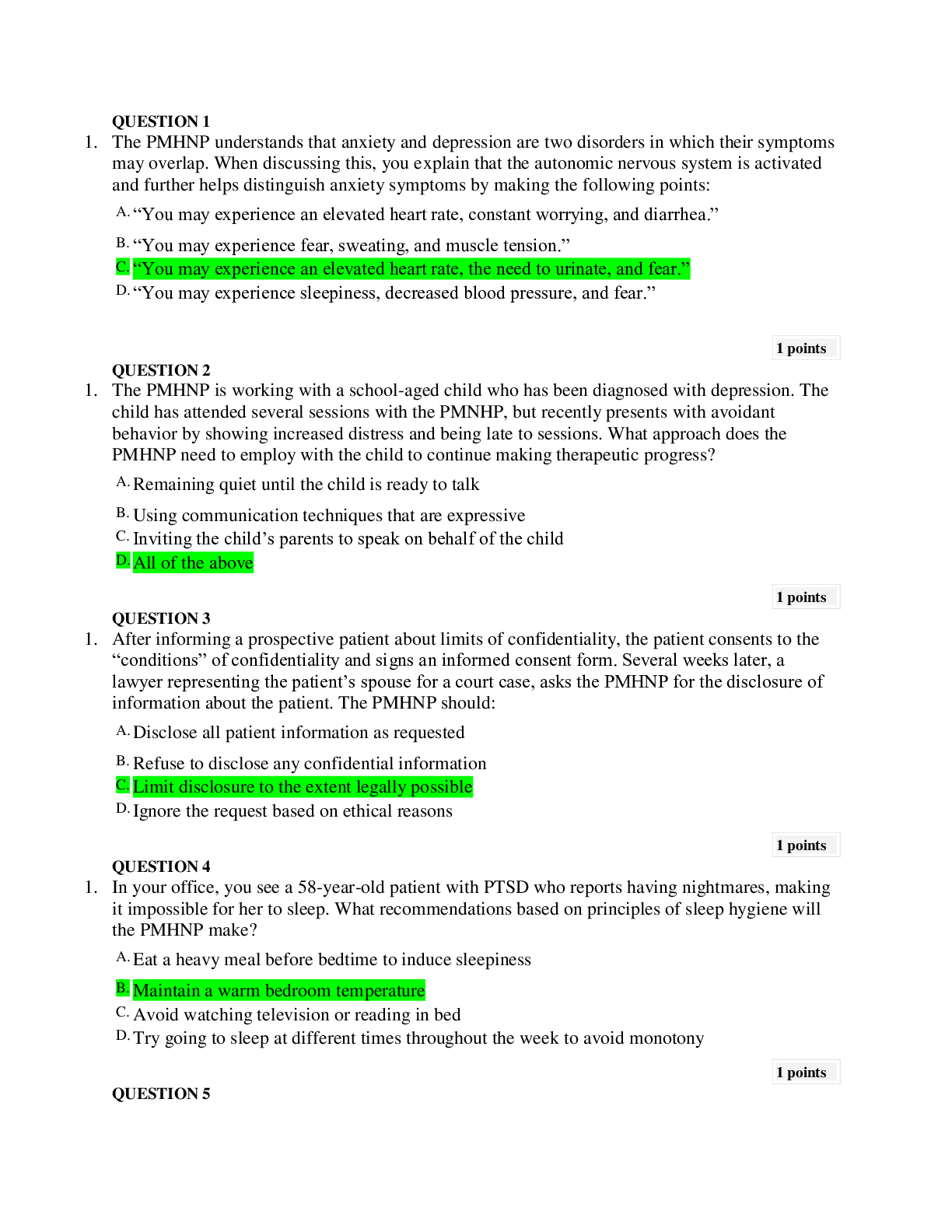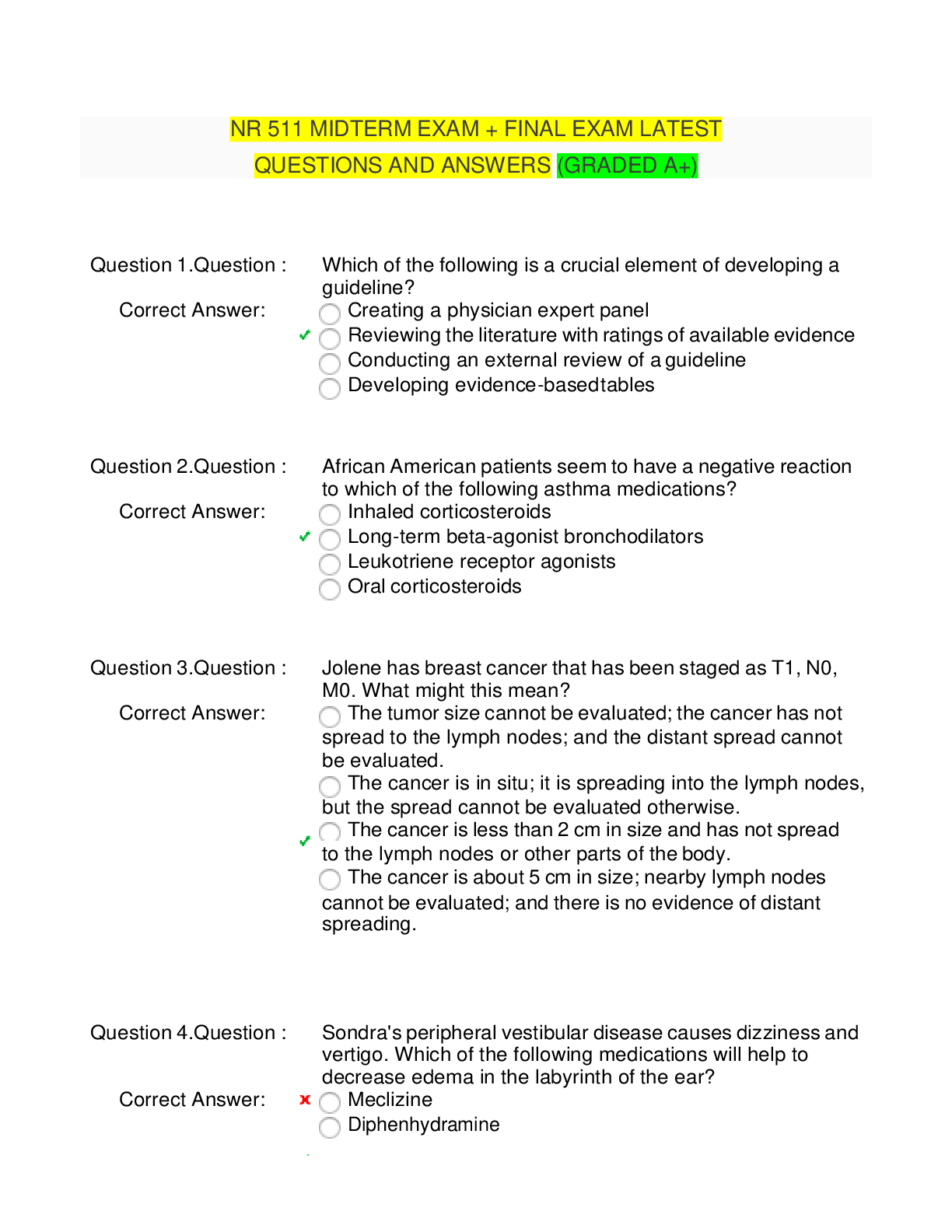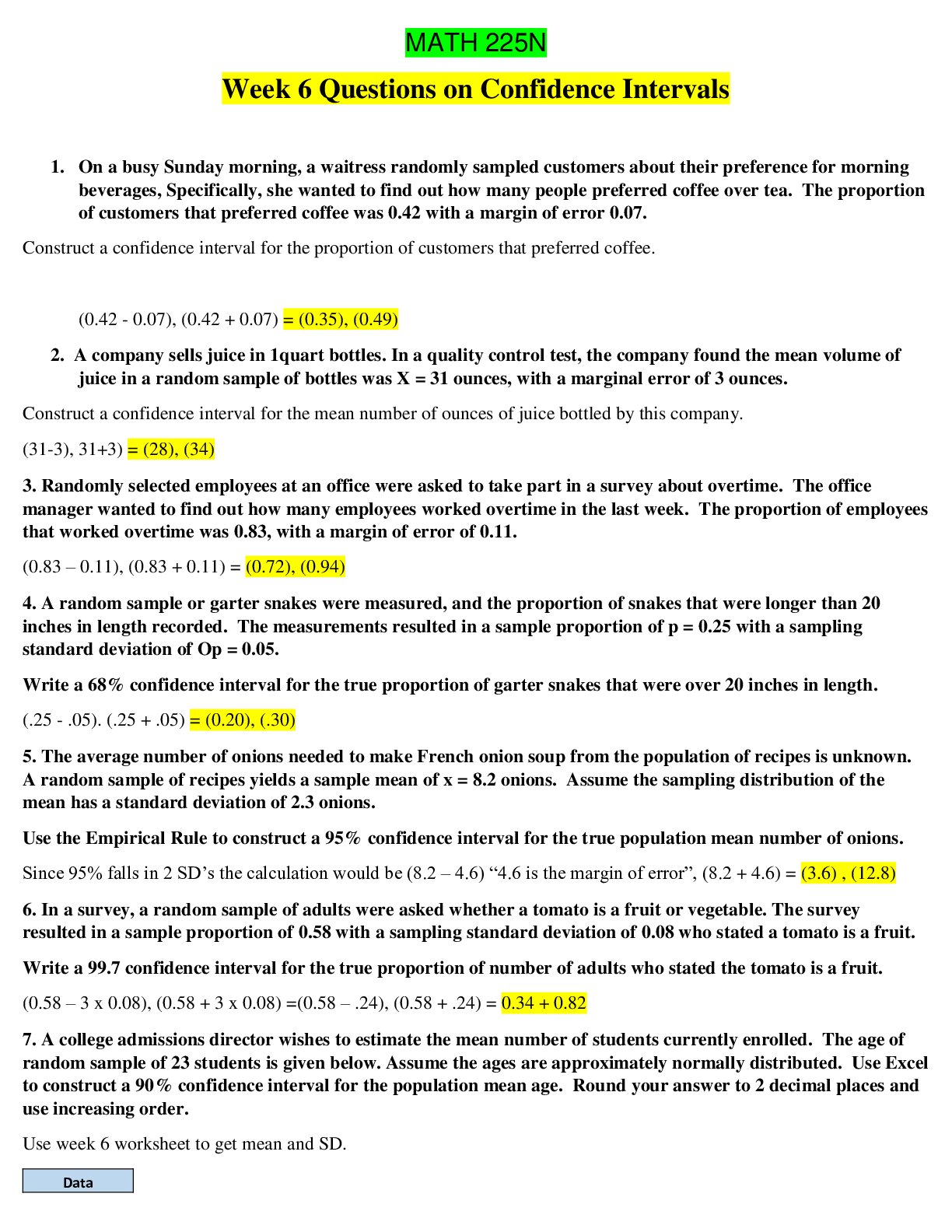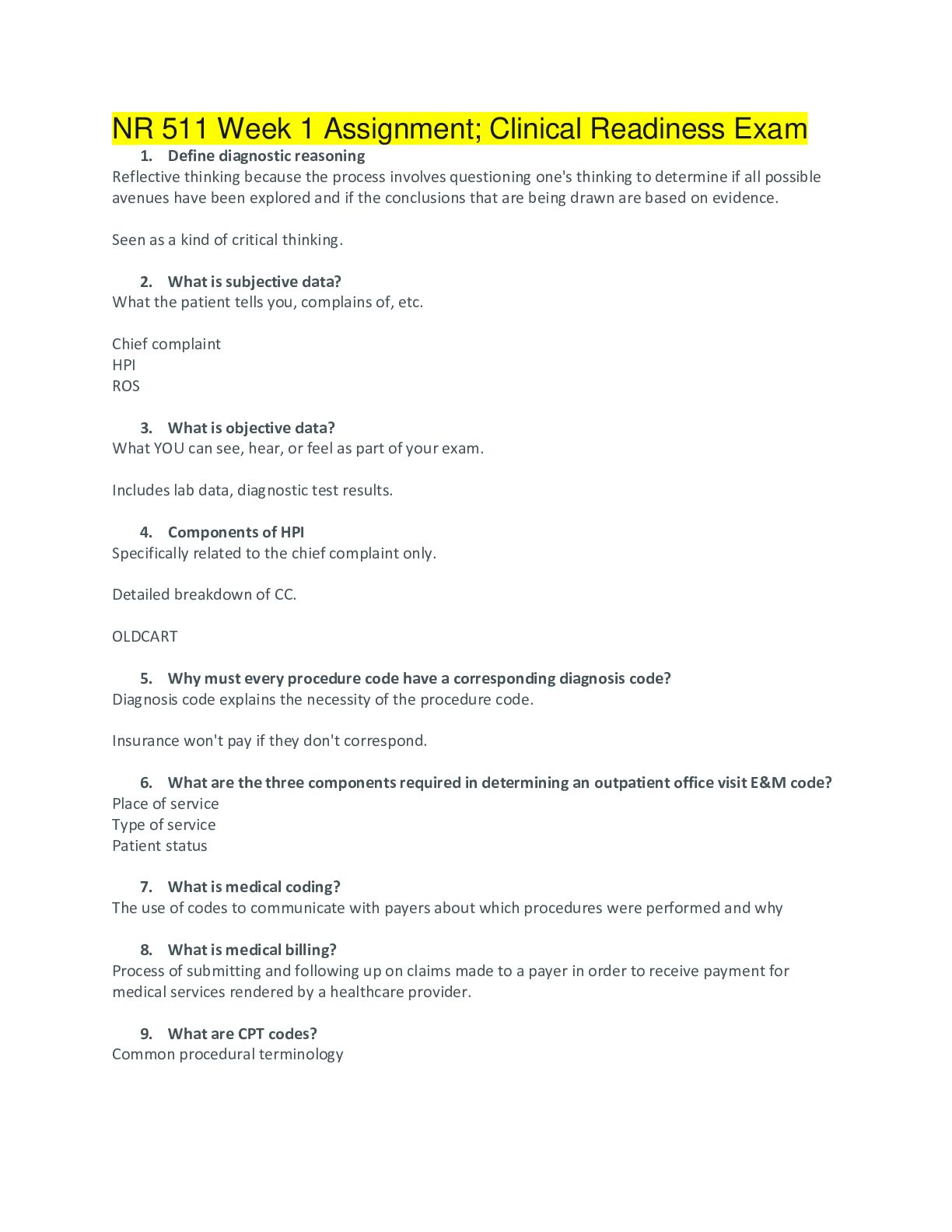Health Care > EXAM > CCE Practice Exam 5 - Questions and Answers (Complete Solutions) (All)
CCE Practice Exam 5 - Questions and Answers (Complete Solutions)
Document Content and Description Below
CCE Practice Exam 5 - Questions and Answers (Complete Solutions) In working with a client who has received a diagnosis of Dissociative Identity Disorder, a cognitive therapist's initial goal would b... e: A. to collaborate with the client to identify specific treatment goals. B. to make a "cognitive diagnosis" for the purpose of developing a concrete treatment plan. C. to identify the cognitive antecedents and consequences that are sustaining the client's multiple personalities. D. to establish a working alliance that provides the client with a sense of safety. A psychologist conducting a study to determine the effectiveness of backward conditioning with human participants will use which of the following procedures? A. Repeatedly present the CS before the US. B. Repeatedly present the US before the CS. C. Apply an intermittent schedule of reinforcement after a continuous schedule has been used to establish a response. D. Apply a continuous schedule of reinforcement after an intermittent schedule has been used to establish a response. Backward conditioning is just the opposite of forward conditioning and involves presenting the US prior to the CS. Backward conditioning is not usually effective. A father wants to increase his son's studying and violin practice and, therefore, reinforces each behavior whenever it occurs with a token that can be exchanged later for a desired privilege. After a period of time, the father realizes that his son will never become a violin virtuoso and stops reinforcing the boy's violin practice. The father can expect which of the following? A. violin practice and studying will both decrease B. violin practice and studying will both increase C. violin practice will decrease but studying will increase D. violin practice will decrease and studying will stay the same Removal of reinforcement from a previously reinforced behavior typically results in an increase in another reinforced behavior. This phenomenon is referred to as "behavioral contrast." When using second-order conditioning to establish a new conditioned response: A. the second conditioned response will not be as strong as the first conditioned response. B. the second conditioned response will be difficult to establish if the second conditioned stimulus is not similar in nature to the first conditioned stimulus. C. the second conditioned response will be more difficult to extinguish than the first conditioned response. D. the second conditioned stimulus will produce "experimental neurosis" if it is too similar to the first conditioned stimulus. Which of the following best describes the difference between escape and avoidance conditioning? A. Escape conditioning is the result of positive reinforcement, while avoidance conditioning is the result of negative reinforcement. B. Escape conditioning is the result of negative reinforcement, while avoidance conditioning is the result of negative punishment. C. Escape and avoidance conditioning are both the result of negative reinforcement, but only escape conditioning combines negative reinforcement with classical conditioning. D. Escape and avoidance conditioning are both the result of negative reinforcement, but only avoidance conditioning combines negative reinforcement with classical conditioning. From the perspective of classical conditioning, persistence of phobias is best explained by which of the following? A. The person with a phobia avoids the conditioned stimulus. B. The fear is automatically conditioned. C. The phobia represents an unconditioned response. D. The person with a phobia fears fear itself Because the phobic individual avoids the conditioned stimulus, he/she never has an opportunity to learn that exposure to it will not result in negative consequences (i.e., that the CS will not be followed by the US). Thus, extinction of the anxiety response does not occur. Tulving has divided memory into three types: procedural, episodic, and semantic. According to Tulving, semantic memory: A. consists of internal representations of stimulus-response connections. B. is more affected by amnesia than procedural memory and episodic memory. C. includes rules for manipulating words and symbols. D. is coded temporally. Children between the ages of approximately _______ years are in the phallic stage of psychosexual development according to Freud and in the initiative vs. guilt stage of psychosocial development according to Erikson. A. 1 to 3 B. 3 to 6 C. 6 to 12 D. 12 to 15 Children between the ages of 3 and 6 are in the third stage of psychosexual development and psychosocial development. Freud referred to the third stage as the phallic stage and Erikson identified the conflict of this stage as involving initiative vs. guilt. As defined by Piaget, assimilation and accommodation are the two components of: A. cognitive organization. B. adaptation. C. decentration. D. decalage. According to Piaget, the ability to think abstractly is first evident at about ____ years of age. A. 6 B. 8 C. 11 D. 15 The formal operational stage is the final stage in Piaget's stage model of cognitive development. It emerges at around age 11. Otitis media (OM) is a frequently-diagnosed childhood disease. Research on the long-term consequences of chronic OM has found that, in general: A. it does not affect hearing ability. B. it is associated with mild hearing loss that has little or no impact on school achievement. C. it is associated with mild to moderate hearing loss that may have a negative impact on school achievement. D. it is associated with profound hearing loss. The hearing loss resulting from OM has been linked to attention problems (especially attention to language) and resulting language deficits, behavioral problems, and lower school achievement. See, e.g., L. Feagans and A. Proctor, The effects of mild illness in infancy on later development: The sample case of the effects of otitis media (middle ear effusion), in C. B. Fisher and R. M. Learner (Eds.), Applied developmental psychology, Cambridge, MA, McGraw-Hill, 1994. Research examining the effects of divorce suggests that maladjustment in children following the divorce of their parents is most likely the result of which of the following? A. the parent's separation B. parental disharmony C. disruption in lifestyle D. diminished parental control The 2013 National Survey on Drug Use and Health found that the largest percentage of respondents ages 12 through 17 used which of the following during the past month? A. hallucinogenics B. marijuana C. tobacco products D. alcohol According to Piaget, the key feature of the _______________ stage is the development of the "semiotic function." A. concrete operational B. preoperational C. sensorimotor D. formal operational The semiotic function refers to the ability to use a symbol, object, or word to stand for something. The preoperational stage extends from ages 2 to 7. During this stage, thought becomes symbolic in form. A sudden loud noise would elicit which of the following reflexes from a one-month old infant? A. Babkin B. Darwinian C. Moro D. Babinski Research investigating the effects of Head Start and similar compensatory education programs has found that these programs: A. have few benefits in terms of academic achievement or other outcomes. B. have some short-term benefits in terms of academic achievement only. C. have benefits in terms of academic outcomes, social adjustment, and employment. D. have few benefits in terms of academic outcomes but some benefits in terms of of social adjustment and employment. Longitudinal studies have found that the immediate effects of compensatory education programs on IQ are often not maintained but that these programs have other positive academic, social, and occupational consequences. Answer C is the best option. The answer summarizes the results of longitudinal studies which have found that improvements in IQ test scores are often not maintained but that children who attend these programs often obtain higher achievement test scores, are less likely to drop out of school, and have lower rates of delinquency and unemployment. A distinguishing feature of the Montessori method is its: A. emphasis on cooperative learning and group achievement. B. use of art and music to teach academic subjects. C. assumption that all learning stems from sense perception. D. placement of children in classes on the basis of developmental level rather than chronological age. The Montessori method is characterized by the use of special materials designed to teach sense discrimination. For example, to facilitate the teaching of reading, large letters of the alphabet are covered with sandpaper. Lev Vygotsky's view of cognitive development is best described as a(n): A. neo-Piagetian theory. B. information processing theory. C. biological-maturationist approach. D. contextual approach. As its name implies, the contextual approach focuses on the specific contexts in which cognitive development occurs. For Vygotsky, the sociocultural context is the most important influence, and he proposed that cognitive development depends on the individual's interactions with other people (i.e., interactions with others in his/her social and cultural milieu). Cognitive dissonance theory and ________ share in common the assumption that an uncomfortable experience or sensation is the primary cause of attitude change. A. the sleeper effect B. attitude inoculation C. balance theory D. the elaboration likelihood model Two weeks before the election for senior class president, the four candidates are given the opportunity to deliver a 10-minute speech during a school assembly. Sally Smart is familiar with research on the recency and primacy effects and, therefore, asks if she can speak: A. first. B. second. C. third. D. fourth. A movie viewer is MOST likely to say he/she feels uncomfortable in a crowded movie theater when the movie is: A. a violent action film. B. a sexually arousing film. C. a boring documentary. D. an amusing comedy. Self-verification theory (Swann, Pelham, and Krull, 1989) predicts that a depressed person will prefer evaluations from others that: A. are consistently non-evaluative. B. are non-emotion-arousing. C. confirm his/her own negative self-evaluations. D. contradict his/her own negative self-evaluations. Research assessing the validity of self-verification theory has, among other things, confirmed that depressed people and people with low self-esteem prefer evaluations that are consistent with their own negative self-evaluations. Professor Sharp argues against raising the legal drinking age from 18 to 21 on the ground that doing so will only encourage 18-, 19-, and 20-year olds to drink. Apparently, Sharp is familiar with which of the following theories? A. individuation B. psychological reactance C. inoculation D. expectancy-value Dr. R. E. Medy compares the effectiveness of three different treatments for Generalized Anxiety Disorder by randomly assigning individuals who have received this diagnosis to one of the three treatments and then measuring their symptoms before treatment and one week, one month, and six months following treatment. The research design used by Dr. Medy is an example of which of the following? A. between groups B. within subjects C. mixed D. counterbalanced Treatment is a between-groups variable in this study - participants are assigned to one of the three treatments. Time is a within-subjects variable - all participants are evaluated on the dependent variable at four different times. When a study includes both between-groups and within-subjects variables, it is referred to as a mixed design. When an assumption for a one-way ANOVA is violated, the best course of action would be to use which of the following to analyze the data? A. Mann-Whitney B. Wilcoxon C. Kruskal-Wallis D. Scheffe The Kruskal-Wallis is the nonparametric alternative to the one-way ANOVA. It can be used to compare two or more independent groups and is useful when one or more of the assumptions for the one-way ANOVA have been violated. A school psychologist wants to determine if there is a significant difference in reading readiness scores between male and female students in the school's preschool program. She obtains scores on a standardized reading readiness test for 17 girls and 13 boys. Which statistical test will be most appropriate for determining if there is a significant difference between the scores obtained by boys and girls? A. two-way ANOVA B. Student's t-test C. Kolmogorov test D. chi-square test for contingency tables A t-test (a.k.a. Student's t-test) is used to compare the mean scores obtained by two groups. Which of the following techniques would be most useful for investigating a person's cognitive processes while working on a complex task? A. production interview B. protocol analysis C. behavioral systems assessment D. event coding Protocol analysis involves having the individual think aloud while solving a problem and then evaluating the protocol (transcript) to clarify the individual's problem-solving process. In multiple regression, an inverse correlation between a predictor and the criterion: A. indicates that a mistake has been made. B. suggests that the predictor should be eliminated from the analysis. C. is indicated by a low regression coefficient. D. is indicated by a negative regression coefficient. In a multiple regression equation, the direction of the correlation between a predictor and criterion is indicated by the sign of the regression coefficient. When there is an inverse (negative) correlation between the variables, the sign is negative. If an investigator changes the level of significance for his research study from .01 to .001, he is: A. less likely to incorrectly retain a false null hypothesis. B. less likely to incorrectly reject a true null hypothesis. C. more likely to incorrectly retain a true null hypothesis. D. more likely to incorrectly reject a true null hypothesis. By decreasing the level of significance from .01 to .001, it becomes harder to reject the null hypothesis. Thus, it is less likely that a true null hypothesis will be rejected (i.e., that a Type I error will be made). Use of which of the following designs involves administering each level of the independent variable to participants so that it appears the same number of times in each position (first, second, etc.)? A. factorial B. time-series C. Latin square D. Solomon For the exam, you want to be familiar with the designs listed in the answers to this question. These are described in the Statistics and Research Design chapter of the written study materials. The Latin square design is a type of counterbalanced design that assures that each treatment (level of the IV) appears an equal number of times in each ordinal position. When the Kuder-Richardson Formula 20 produces a coefficient of .98, this means that: A. the items in the test are homogeneous. B. the trait being measured by the test is stable over time. C. the measuring instruments are equivalent. D. the test measures what it was designed to measure. As a measure of internal consistency, a high KR-20 coefficient indicates a homogeneous test. The slope of an item characteristic curve provides information on which of the following? A. reliability B. difficulty level C. discrimination D. probability of guessing correctly The slope of the curve indicates the item's ability to discriminate between low and high achievers. The "flatter" the slope, the less the item's discrimination. A test developer is asked to develop a test to evaluate the effects of a training program on the sales success of inexperienced sales employees. When establishing the validity of the test, the test developer will probably be MOST interested in which of the following types of test validity? A. discriminant B. content C. criterion-related D. construct Criterion-related validity refers to the relationship between test scores and a criterion measure. In this case, the test developer will be interested in the degree to which training outcome correlates with the criterion of job performance. Thus, the test developer will be interested in assessing the criterion-related validity of the test. A researcher obtains a correlation coefficient of .85 when he correlates the raw scores participants received on her study's predictor and criterion. If the researcher converts each participant's raw scores to non-normalized T scores and calculates a correlation coefficient, this coefficient will be: A. larger than .85. B. smaller than .85. C. .85. D. -0.85 A linear transformation of raw scores affects a distribution's mean and standard deviation but does not change is shape. (Note that raw scores can also be converted to normalized T scores when scores obtained by a sample are not normally distributed but there is reason to believe that the distribution is normal in the population. In this case, the correlation coefficient would be affected by the transformation.) A psychologist administers a 100-item true/false test to 50 examinees. The mean of the score distribution is 60 and its standard deviation is 8. If the psychologist decides to correct each examinee's score using a correction for guessing formula that involves subtracting points from examinees' scores, she can expect that: A. the mean and standard deviation of the new distribution will both be lower. B. the mean and standard deviation of the new distribution will both be higher. C. the mean of the new distribution will be lower and its standard deviation will be higher. D. the mean of the new distribution will be higher and its standard deviation will be lower. Unless you do a lot of testing, you're probably not familiar with the correction for guessing formula. If you are, you may have figured out the answer to this question by applying the formula to a concrete example. To illustrate, assume that a 10-item true/false test is administered to three examinees who achieve scores of 10, 6, and 2. The mean of this distribution is 6 and its standard deviation is 4. Using the above formula, the corrected distribution of scores is 10, 2, and -6. The mean of this corrected distribution is 2 and its standard deviation is 8. (Even without calculating the standard deviation for the two distributions, it is clear by looking at them that there is greater variability in scores in the second distribution.) In principal components analysis, each eigenvalue indicates: A. the total variance explained by an identified component. B. the total variance explained by all of the identified components. C. the variance shared by each test and an identified component. D. the total variance shared by all of the tests and all of the identified components. An eigenvalue for each principal component is calculated by squaring the correlation between each test and the component and then summing the results. The resulting number indicates the total amount of variability in the tests that is explained by the principal component. Overall, research investigating the effects of examiner race on the performance of African American children on IQ tests suggests that: A. the performance of African American children is significantly suppressed when the examiner is White. B. the performance of African American children is significantly improved when the examiner is African American. C. the performance of African American children is enhanced somewhat when the examiner is White and clearly unbiased. D. the performance of African American children is affected more by the examiner's testing experience and attitudes than by his or her race. This is the best conclusion that can be drawn from the existing studies. When an examiner's race appears to have an impact on the examinee's performance, it is often the result of factors other than race. (Even Arthur Jensen found that, when a White examiner adopted a more informal style with African American children, the children's scores on IQ tests were higher.) Which of the following tests is based on the PASS model of intelligence? A. Columbia Mental Maturity Scale B. Fagan Test C. Cognitive Assessment System D. Wonderlic [Show More]
Last updated: 3 weeks ago
Preview 5 out of 26 pages
Instant download

Loading document previews ...
Buy this document to get the full access instantly
Instant Download Access after purchase
Add to cartInstant download
Also available in bundle (1)
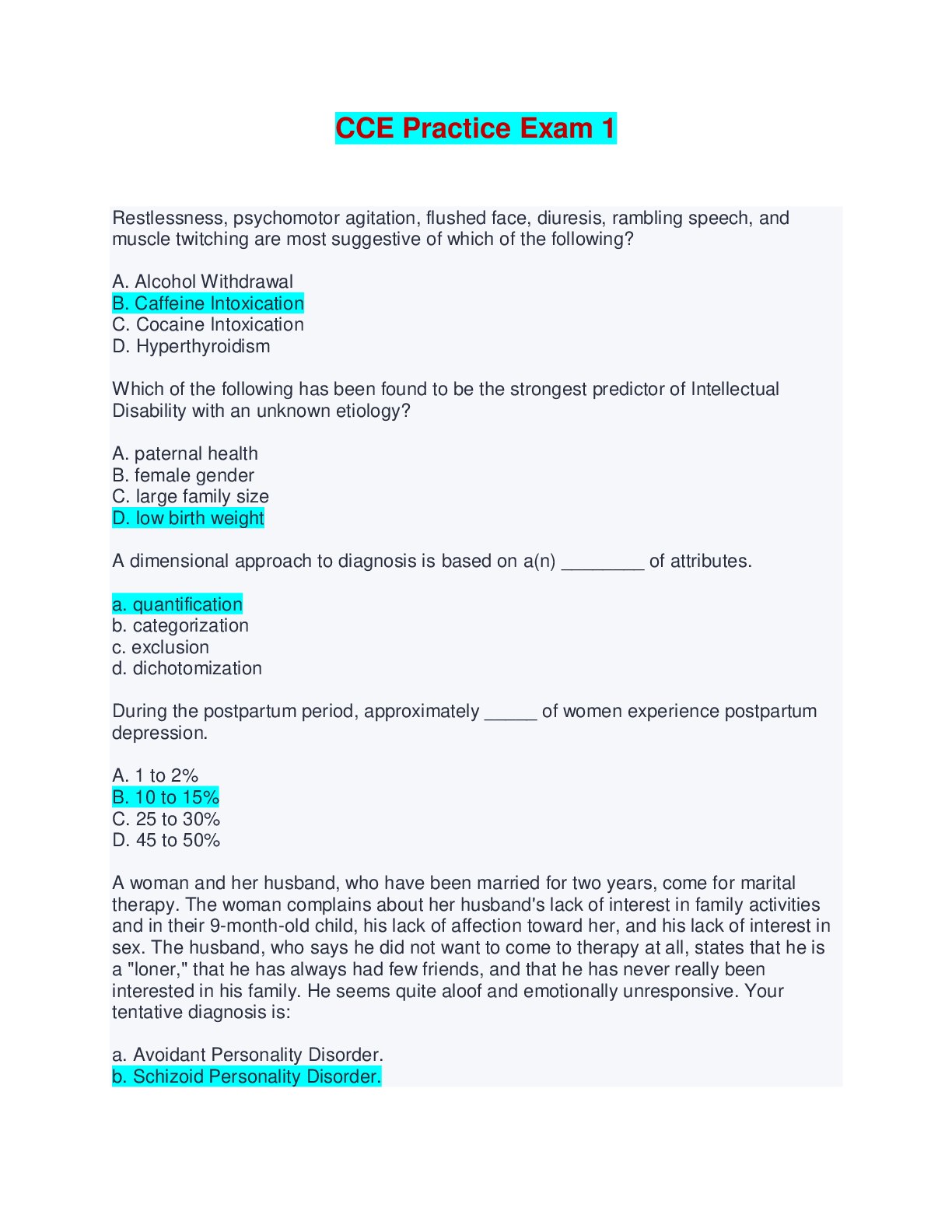
CCE PRACTICE EXAM 1 - 6 BUNDLE
CCE PRACTICE EXAM 1 - 6 BUNDLE
By Nurse Henny 2 weeks ago
$50
6
Reviews( 0 )
Document information
Connected school, study & course
About the document
Uploaded On
Jun 05, 2024
Number of pages
26
Written in
Additional information
This document has been written for:
Uploaded
Jun 05, 2024
Downloads
0
Views
8



